This trip was planned at the last minute, as it wasn't clear whether Natalia would be able to extend her trip thanks to Malaysian Immigration's archaic attitudes toward Colombian Nationals. But once she sorted things at the migration office, the round trip tickets from Zurich to Kuala Lumpur (KL) for $457 convinced me that I couldn't afford to stay home for this one.
After the rough adventure of Kalimantan (see
The Kalimantan Krush), I had myself mentally braced for trying times as I flew to meet Natalia in Sabah. But the Malaysian part of Borneo proved to be a world apart from its Indonesian neighbor to the south.
When people say they are going birding in Borneo, there's better than a 99% chance they're hitting up Sabah, and for good reason. Over the past couple decades Sabah has fashioned itself into a kind of birder's Disney Land, with excellent accommodations, food, and wildlife-focused parks.
Mount Kinabalu National Park, certainly a must-visit for birders hoping to see some of Borneo's montane endemics, was our first stop.
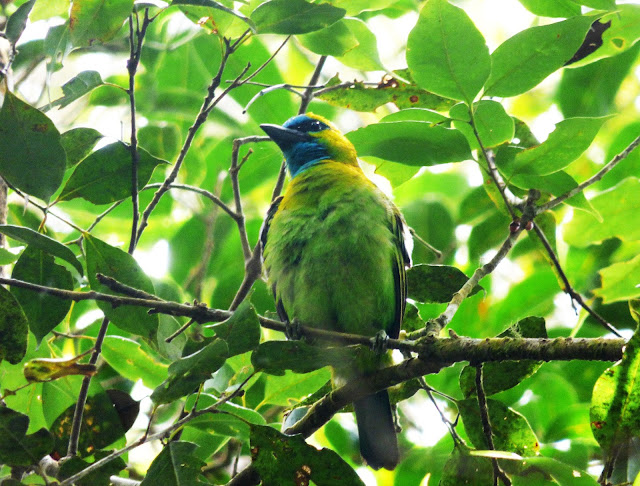 |
| Golden-naped Barbet, Mount Kinabalu - our first Bornean Endemic |
 |
| Black-sided (or 'Bornean') Flowerpecker, another endemic |
Most visitors to the park are non-birders who want to summit the 4000 m elevation peak, but the best bird action is along the power station road and excellent network of trails that crisscross pristine cloud forest habitats below 1900 m.
 |
| Gray-chinned Minivet pair, Mount Kinabalu |
The most important bird targets here are the "Whitehead's Trio": Trogon, Broadbill and Spiderhunter, the latter of which graces the front cover of the Phillipps' field guide. We spent a couple days prowling the park and while 52 doesn't sound like an impressive bird list, 14 of these were Bornean endemics, including the Whitehead's Spiderhunter and crippling views of a Whitehead's Broadbill.
 |
| Whitehead's Broadbill, a highly sought-after Bornean endemic |
 |
| that's the stuff; nice spot Natalia! |
The Park offers such excellent access to so many range-restricted species that it also popular with biologists and a very large proportion of the birds we saw sported color bands.
 |
| Bornean Whistling-Thrush (an endemic) color-banded |
Most of the bird tours spend 3 or 4 days at the park, but it seemed like we had pretty much hit diminishing returns on the local bird life after just two, so we decided to check out Poring Hotsprings, which lived up to its reputation as 'boring poring.' The one trail is really steep and had few birds. We hiked around all morning and found only 22 species! The place does have a really cool canopy walkway, which unfortunately doesn't open until 8 am.
We continued on to the Rafflesia Information Center at the Crocker Range National Park, which is supposed to be better for some of the mountain endemics that are extra rare at Kinabalu. Birding here was also disappointing and of the endemic targets here (i.e. Fruithunter, Montane Barbet, Bornean Barbet to name a few) we only managed Bornean Bulbul. Despite the poor reviews, we had a pleasant stay at the nearby dilapidated Gunung Alab resort/motel.
Natalia had to get back to work co-instructing a forest ecology field course, so we flew Kota Kinabalu to Sandakan to join the group at Sepilok, which fortunately for us, is a kind of birding Mecca. The Rainforest Discovery Center at Sepilok has taken the concept of canopy walkway and canopy tower and to a new level. It has four steel towers of varying heights and a long stable and wide elevated walkway that links two of them. They have plans to eventually join all four towers with the walkway.
 |
| Natalia at the Rainforest Discovery Center canopy walkway, Sepilok |
Although lowland Sabah forests have been devastated by the same wave of oil palm development that has Krushed Kalimantan, the big difference is that Sabah has not only set aside protected areas, but also aggressively developed them into ecotourism destinations. Sepilok is one such highly developed ecotourism destination. In reality it is just a small island of pristine forest in a sea of oil palm desert, but its a big enough oasis to support a lot of endangered, endemic and charasmatic wildlife and is now fringed by high-end resorts that bring in tourists from all over the world hoping to glimpse an orangutan or a bristlehead.
Speaking of bristlehead (i.e. Bornean Bristlehead) it is far and away the top target for birders at Sepilok. Heck, given that it's the sole species of the endemic Pityriaseidae family, it's arguably the most important bird in all of Borneo. The Phillipps' book advertises it as 'common' at Sepilok. While it may have been commonly viewed and photographed at Sepilok years ago, recent sightings have been few and far between.
We asked everybody with binoculars or a camera about the bristleheads, hoping for some local intelligence. Nobody had seen a bristlehead recently and yet everybody advocated for the same strategy: bird the canopy walkway in the early morning or the later afternoon and listen for their odd nasal calls. We spent a lot of time on the canopy walkway and I began to wonder if the Wallace's Hawk-Eagles nesting above it weren't part of the reason why the Bristleheads had become so shy.
 |
| Wallace's Hawk-Eagle eating [something]. A pair was nesting almost directly above the Trogon Tower on the canopy walkway. |
One of the interns at the Sunbear Center told me it took her two years to see her first Bristlehead, so I pretty much wrote this bird off as a miss. Luckily there were plenty of other interesting birds around the canopy towers to marvel at while the Bristleheads didn't show.
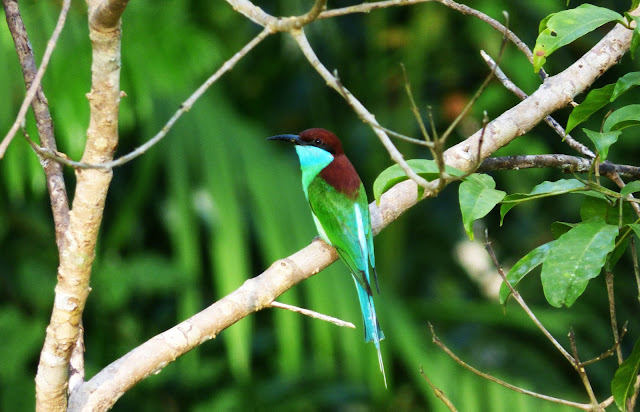 |
| Blue-throated Bee-Eater -- not a rare bird, but a looker indeed |
 |
| Ruby-cheeked Sunbird, another common attractive bird at Sepilok |
How about some Hornbills? Try the 27 m Hornbill Tower!
 |
| Asian Black Hornbill (female) |
 |
| Bushy-crested Hornbill |
 |
| Oriental Pied Hornbill |
But there's only so much waiting one can do and there were certainly other birds for us to see along the trails. Many of the trip reports recommended the Kingfisher Trail, but other than a friendly Purple-naped Spiderhunter...
 |
| Purple-naped Spiderhunter |
...and Short-tailed Babbler...
 |
| Short-tailed Babbler |
... it was consistently pretty quiet. No sign of the Rufous-collared Kingfisher here (the one we wanted), in fact I walked that trail at least three times and only saw a Blue-eared Kingfisher (common bird) once, the only kingfisher we saw at Sepilok. It had been really dry and the creek level was low; this probably had something to do with it.
We ended up having much better luck on the Pitta Trail. First we stumbled upon the elusive White-crowned Hornbill and then interrupted some sort of dispute between the two biggest of Bornean woodpeckers:
 |
| This White-bellied Woodpecker (a Dryocopus, the same genus as North America's Pileated Woodpecker) seemed to get the better end of the deal and happily foraged on this fat rotting snag |
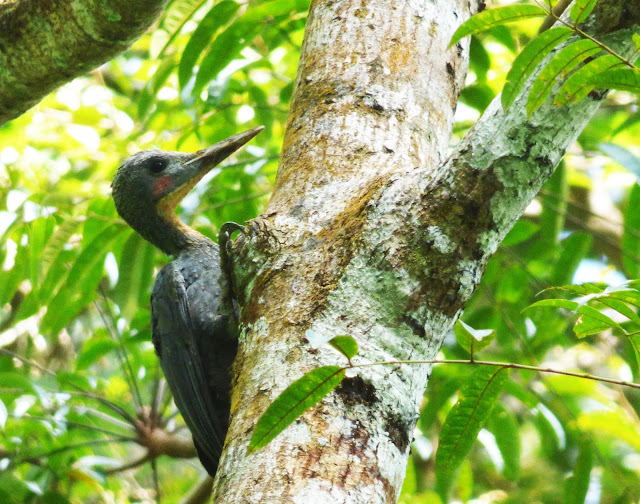 |
| All the while this Great Slaty Woodpecker (the world's largest Piciformes) scolded him from a nearby tree |
And then we came upon an aggressive Black-crowned Antpitta (another endemic) that came charging out onto the trail when we played him some tape.
 |
| Black-crowned Antpitta, a Sepilok poster bird |
The last morning of Natalia's course I went out birding on my own and wasn't having a terribly productive time of it until I ran into another pair of birders I recognized from back at Kinabalu National Park. We had exchanged a few words with these guys as we criss-crossed paths time and again..just helpful bird sightings advice as friendly birders do in the field. This time they gave me a real nice nugget: Bornean Brown Barbets and a Red-naped Trogon at the far end of the Pitta Trail.
 |
| Bornean Brown Barbet (endemic) excavating a nest cavity out of an active termite colony. His/her partner was sitting on a nearby branch. I watched them for 20 minutes take turns digging and getting covered in termites. |
Natalia was free after lunch, so I brought her back to the spot where the barbets were still going hard at it. As she was taking photos I noticed an odd quiet call from nearby. Eventually I located a gorgeous male Red-naped Trogon.
 |
| Red-naped Trogon -- doesn't make up for missing Whitehead's Trogon at Mount Kinabalu, but a beautiful lifer |
 |
| Red-naped Trogon |
We took our time enjoying and photographing the barbets and trogon and just around the time we might have begun to start thinking about moving on, Natalia caught a glimpse of a large black bird in the canopy as she swigged from her water bottle.
Oh my god it's the Bristlehead! The water bottle nearly crashed to the ground.
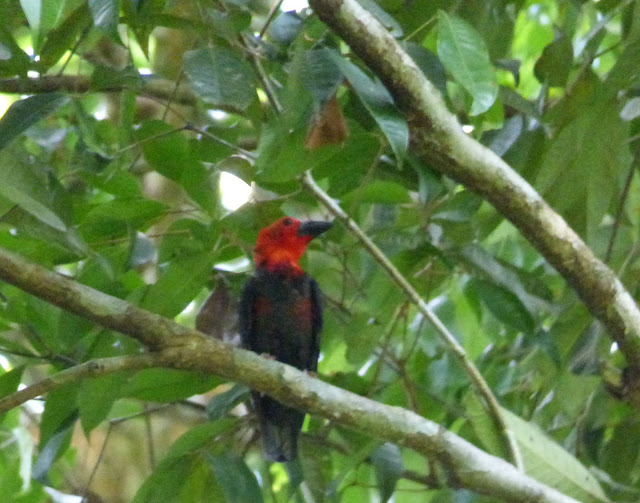 |
| Bornean Bristlehead (immature), Sepilok |
!!!!!
After all the advice about looking at the canopy tower in the very early morning, here were looking up at three feeding Bristleheads on one of the trails at 3 in the afternoon. So much for conventional wisdom.
 |
| Bornean Bristlehead (adult), Sepilok |
It was yet another amazing spot by Natalia. She had one final one left in the bag.
That night we met the students at the canopy walkway to watch the giant flying squirrels emerge (an awesome sight; we did this three nights in a row). As we walked our way out to the parking lot to hop a taxi back to the resort, Natalia noticed what she first thought was a tarsier in her flashlight beam.
 |
| The tarsier turned its head and revealed itself to be this Oriental Bay Owl, a tough bird to find! |
With the course wrapped up, we were free to move on to the Kinabatangan River. The landscape here has been severely fragmented by oil palm development over the past four decades which makes it an important area to visit for Natalia's research on birds in oil palm landscapes. The remnant forested riparian corridors, made ever more important for wildlife hemmed in by the oil palm deserts, have, somewhat paradoxically, become famous for ecotourism. Fancy lodges have sprung up along the putrid and often smelly Kinabantangan's banks drawing a steady stream of tourists hoping to glimpse or photograph a Proboscis Monkey or a Bornean Elephant.
Conveniently for us the Kinabatangan is also excellent for birding and we signed up for a birding package with the resident bird guru Robert Chong. His lodge and fees aren't cheap by Malaysia standards, but as he offers the best chance in the world to see the endemic Bornean Ground-Cuckoo and a handful of difficult pittas, going with him is well worth the cost.
When the Kinabatangan Jungle Camp bus showed up to pick us up from Sepilok, who should be inside but the same pair of birders we had met on the trails of Mount Kinabalu and Sepilok over the previous week.
Turns out we had been birding a parallel itinerary with a pair of Belgian kings of the world of birding. The guy with the parabolic mike and the prosthetic leg turned out to be
Peter Boesman, the most prolific bird sound recordist in the world. Seriously, nobody else has contributed so many vocalizations (circa 26,000) to xeno-canto.org. Peter has double-legendary status for also losing his leg to a bushmaster bite in the Peruvian Amazon some 20 years ago. His Swarovski-scope-wielding accomplice turned out to be Mark Van Beirs, a 30-year veteran bird guide for tour company Bird Quest and the #7 world life lister (he ticked #9000 on this trip to Borneo) according to the
scoreboards over at Surfsbirds.com (you hear that,
Seagull Steve? The actual world #7 in the flesh!).
 |
| We found ourselves birding with Belgian birding celebrities (if such a thing exists) Peter Boesman and Mark Van Beirs (insert culturally insensitive joke about waffles and/or chocolate here). If you notice a down-tick in Peter Boesman's xeno-canto.org sound uploads, it's probably because I talked over most of his recordings. Countless potential new splits eluded adequate vocal documentation thanks to me. |
The Belgians proved themselves worthy of their lofty reputations immediately by spotting roosting Brown Wood-Owls just behind our cabin.
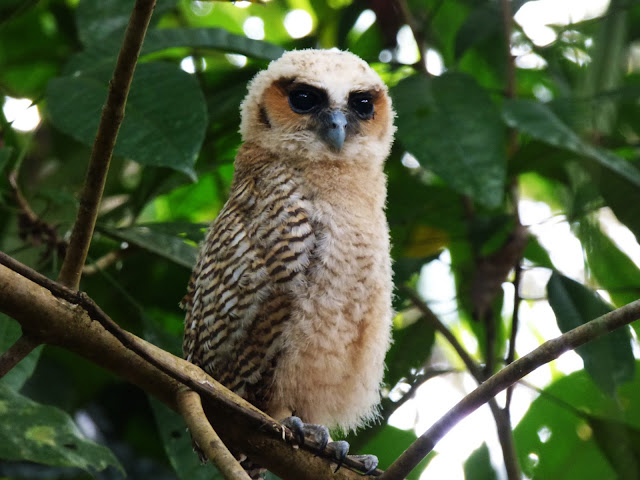 |
| Brown Wood-Owl juvenile, Kinabatangan Jungle Camp |
 |
| Brown Wood-Owl adult, Kinabatangan Jungle Camp |
Otherwise the birding in this area is nearly 100% done by boat, which is great for photography. A few of the more common specimens:
 |
| Gray-headed Fish-Eagle, not to be confused with the similar Lesser Fish-Eagle |
 |
| Oriental Darter, the Southeast Asian cousin of North America's Anhinga |
 |
| Blue-eared Kingfisher, with the possible exception of Stork-billed, the most common kingfisher here |
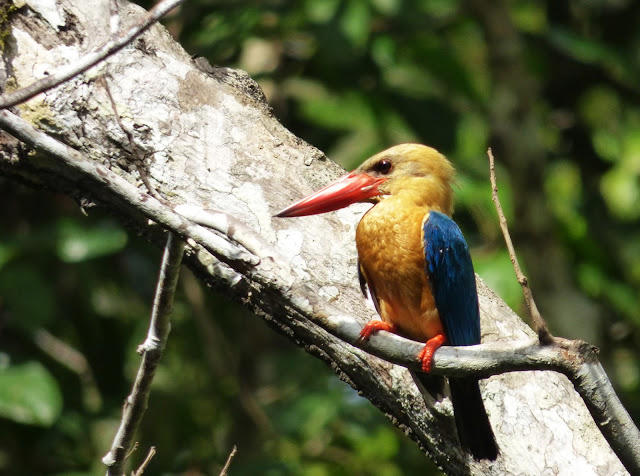 |
| Stork-billed Kingfisher, the other most common Kingfisher. |
 |
| Black-and-red Broadbill, affectionately referred to by local guides as 'Angry Bird.' These things were building nests all along the river banks. |
 |
| Wrinkled Hornbill (male), yes these are quite common on the Kinabatangan. |
 |
| What the hell is this thing? Apparently in Southeast Asia in breeding condition Great Egrets have dark bills with blue facial skin and pinkish thighs. Peter Boesman and I nearly came to blows over this ID. He insisted that these birds were too small to be Great Egrets and I was ready to concede that the Phillipps' Guide illustrations might be totally worthless. Later side-by-side views of the egret trio (Great, Intermediate, Little) confirmed and vindicated the Phillipps' rendering |
Sadly we ended up dipping on the Ground-Cuckoo, only hearing a few distant calls, and had no luck with any of the elusive pittas. Otherwise the birding was excellent (as was the birding company), so we weren't as bothered as we probably should have been.
 |
| We got great looks at this ugly Lesser Adjutant, one of the two threatened stork targets here |
 |
| Storm's Stork, the second threatened stork target, also put in a good showing |
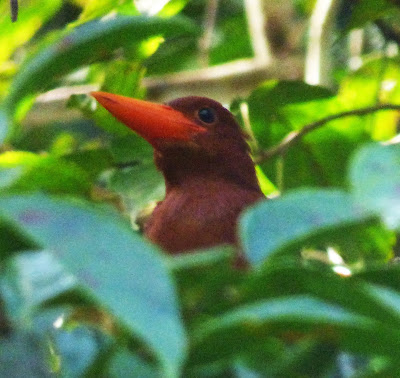 |
| Natalia's favorite bird of the Kinabatangan was this Ruddy Kingfisher (poorly named, this bird is a gorgeous deep purple) |
 |
| White-crowned Hornbill. One of three lifers Mark Van Beirs ticked on his first day out with us on the Kinabatangan. The other two were Large Frogmouth and Chestnut-winged Cuckoo |
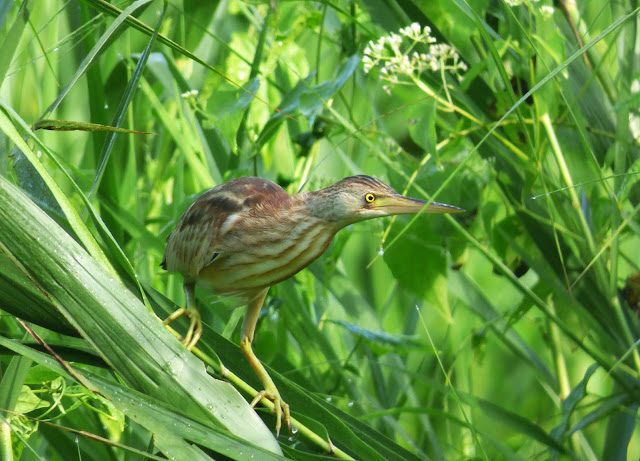 |
| I finally got my second Ixobrychus species in a cooperative Yellow Bittern that clumsily clamored in the emergent vegetation |
We left the Kinabatangan at the last possible minute, heading straight to the Sandakan airport to catch successive flights to Kota Kinabalu and on to Kuala Lumpur for a brief stopover in Peninsular Malaysia before the jaunt back to Switzerland.
It seems incredible that after spending 4 weeks in Kalimantan we could return to Borneo and tick 111 new species with relative ease. Comparing lists and effort from these two adjacent states speaks to the huge difference in birding opportunities. Kalimantan -- 177 species in 4 weeks; Sabah -- 200 species in 10 days.
Conclusion? Go birding in Sabah. There are a lot of interesting endemics to search for, the ecotourism infrastructure is world class and costs are relatively low. When you go, be sure to run into Peter Boesman and Mark Van Biers for a guaranteed fun time.






































